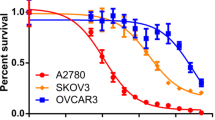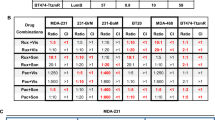Abstract
We evaluated the antitumor activity of the Bax gene and green fluorescent protein/tumor necrosis factor-related apoptosis-inducing ligand (GFP/TRAIL) fusion gene driven by the human telomerase reverse transcriptase promoter both separately and combined in the human ovarian cancer lines SKOV3ip and DOV13 and human lung cancer line H1299. In vitro study showed that both TRAIL- and Bax-expressing vectors elicited significant cell killing in H1299 and SKOV3ip cells, but only the GFP/TRAIL gene elicited significant cell killing in DOV13 cells. Combined TRAIL and Bax therapy also produced more profound cell killing in SKOV3ip and H1299 cells, but not DOV13 cells without escalation of the vector doses. To further evaluate the combined effects of Bax and TRAIL, abdominally spread tumors were established in nude mice via intraperitoneal inoculation of SKOV3ip cells followed by that of adenoviral vectors. Tumor growth, ascites formation, survival duration and toxicity were evaluated after treatment. We found that treatment using the Bax- or TRAIL-expressing vector alone significantly suppressed tumor growth and ascites formation, and prolonged animal survival when compared with that of using PBS or a control vector. Combined TRAIL and Bax therapy further prolonged survival significantly when compared with therapy using the TRAIL or Bax gene alone. Transgene expression and apoptosis induction were not detected in normal human ovarian epithelial cells in vitro or normal mouse tissues in vivo after intraperitoneal vector administration. Also, liver toxicity was not detected after either treatment. Thus, combined TRAIL and Bax gene therapy may be useful for treatment of abdominally spread tumors.
This is a preview of subscription content, access via your institution
Access options
Subscribe to this journal
Receive 12 print issues and online access
$259.00 per year
only $21.58 per issue
Buy this article
- Purchase on Springer Link
- Instant access to full article PDF
Prices may be subject to local taxes which are calculated during checkout





Similar content being viewed by others
References
Thompson CB . Apoptosis in the pathogenesis and treatment of disease Science 1995 267: 1456–1462
Fisher DE . Apoptosis in cancer therapy: crossing the threshold Cell 1994 78: 539–542
Houghton JA . Apoptosis and drug response Curr Opin Oncol 1999 11: 475–481
Kaufmann SH, Earnshaw WC . Induction of apoptosis by cancer chemotherapy Exp Cell Res 2000 256: 42–49
Adams JM, Cory S . The Bcl-2 protein family: arbiters of cell survival Science 1998 281: 1322–1326
Ashkenazi A, Dixit VM . Death receptors: signaling and modulation Science 1998 281: 1305–1308
Korsmeyer SJ et al. Bcl-2/Bax: a rheostat that regulates an anti-oxidant pathway and cell death Semin Cancer Biol 1993 4: 327–332
Hetts SW . To die or not to die: an overview of apoptosis and its role in disease JAMA 1998 279: 300–307
Jurgensmeier JM et al. Bax directly induces release of cytochrome c from isolated mitochondria Proc Natl Acad Sci USA 1998 95: 4997–5002
Pastorino JG et al. The overexpression of Bax produces cell death upon induction of the mitochondrial permeability transition J Biol Chem 1998 273: 7770–7775
Liu X et al. Induction of apoptotic program in cell-free extracts: requirement for dATP and cytochrome c Cell 1996 86: 147–157
Kluck RM, Bossy-Wetzel E, Green DR, Newmeyer DD . The release of cytochrome c from mitochondria: a primary site for Bcl-2 regulation of apoptosis Science 1997 275: 1132–1136
Oltvai ZN, Milliman CL, Korsmeyer SJ . Bcl-2 heterodimerizes in vivo with a conserved homolog, Bax, that accelerates programmed cell death Cell 1993 74: 609–619
Pan G et al. The receptor for the cytotoxic ligand TRAIL Science 1997 276: 111–113
Walczak HT et al. RAIL-R2: a novel apoptosis-mediating receptor for TRAIL EMBO J 1997 16: 5386–5397
Pan G et al. An antagonist decoy receptor and a death domain-containing receptor for TRAIL Science 1997 277: 815–818
Sheridan JP et al. Control of TRAIL-induced apoptosis by a family of signaling and decoy receptors Science 1997 277: 818–821
Degli-Esposti MA et al. The novel receptor TRAIL-R4 induces NF-kappaB and protects against TRAIL-mediated apoptosis, yet retains an incomplete death domain Immunity 1997 7: 813–820
Emery JG et al. Osteoprotegerin is a receptor for the cytotoxic ligand TRAIL J Biol Chem 1998 273: 14363–14367
Kagawa S et al. Antitumor effect of adenovirus-mediated Bax gene transfer on p53-sensitive and p53-resistant cancer lines Cancer Res 2000 60: 1157–1161
Gu J et al. Tumor-specific transgene expression from the human telomerase reverse transcriptase promoter enables targeting of the therapeutic effects of the Bax gene to cancers Cancer Res 2000 60: 5359–5364
Li X et al. Adenovirus-mediated Bax overexpression for the induction of therapeutic apoptosis in prostate cancer Cancer Res 2001 61: 186–191
Tai YT, Strobel T, Kufe D, Cannistra SA . In vivo cytotoxicity of ovarian cancer cells through tumor-selective expression of the BAX gene Cancer Res 1999 59: 2121–2126
Kagawa S et al. Antitumor activity and bystander effects of the tumor necrosis factor-related apoptosis-inducing ligand (TRAIL) gene Cancer Res 2001 61: 3330–3338
Griffith TS et al. Adenoviral-mediated transfer of the TNF-related apoptosis-inducing ligand/Apo-2 ligand gene induces tumor cell apoptosis J Immunol 2000 165: 2886–2894
Fang B, Koch P, Roth JA . Diminishing adenovirus gene expression and viral replication by promoter replacement J Virol 1997 71: 4798–4803
Fang B, Ji L, Bouvet M, Roth JA . Evaluation of GAL4/TATA in vivo. Induction of transgene expression by adenovirally mediated gene codelivery J Biol Chem 1998 273: 4972–4975
Kagawa S et al. A binary adenoviral vector for expressing high levels of the proapoptotic gene bax Gene Therapy 2000 7: 75–79
Gu J, Andreeff M, Roth JA, Fang B . hTERT promoter induces tumor-specific Bax gene expression and cell killing in syngenic mouse tumor model and prevents systemic toxicity Gene Therapy 2002 9: 30–37
McGuire WP . Primary treatment of epithelial ovarian malignancies Cancer 1993 71: 1541–1550
Arafat WO et al. An adenovirus encoding proapoptotic Bax induces apoptosis and enhances the radiation effect in human ovarian cancer Mol Ther 2000 1: 545–554
Tsuruta Y et al. Combination effect of adenovirus-mediated pro-apoptotic bax gene transfer with cisplatin or paclitaxel treatment in ovarian cancer cell lines Eur J Cancer 2001 37: 531–541
Xiang J et al. Pro-apoptotic treatment with an adenovirus encoding Bax enhances the effect of chemotherapy in ovarian cancer J Gene Med 2000 2: 97–106
Kagawa S et al. Deficiency of caspase-3 in MCF7 cells blocks Bax-mediated nuclear fragmentation but not cell death Clin Cancer Res 2001 7: 1474–1480
Croyle MA, Yu QC, Wilson JM . Development of a rapid method for the PEGylation of adenoviruses with enhanced transduction and improved stability under harsh storage conditions Hum Gene Ther 2000 11: 1713–1722
Ohsawa T, Nakamura T, Mihara M, Sato K . Enhancement of adenovirus-mediated gene transfer into dermal fibroblasts in vitro and in vivo by polyethylene glycol 6000 J Dermatol 2000 27: 244–251
O'Riordan CR et al. PEGylation of adenovirus with retention of infectivity and protection from neutralizing antibody in vitro and in vivo Hum Gene Ther 1999 10: 1349–1358
Chillon M, Lee JH, Fasbender A, Welsh MJ . Adenovirus complexed with polyethylene glycol and cationic lipid is shielded from neutralizing antibodies in vitro Gene Therapy 1998 5: 995–1002
Siemens DR et al. Cutting edge: restoration of the ability to generate CTL in mice immune to adenovirus by delivery of virus in a collagen-based matrix J Immunol 2001 166: 731–735
Kruk PA, Maines-Bandiera SL, Auersperg N . A simplified method to culture human ovarian surface epithelium Lab Invest 1990 63: 132–136
Koch P et al. Augmenting transgene expression from carcinoembryonic antigen (CEA) promoter via a GAL4 gene regulatory system Mol Ther 2001 3: 278–283
Acknowledgements
We thank Dr Mien-Chie Hung for providing SKOV3ip cells, Karen Ramirez for assistance in FACS analysis, Allan Prejusa and Trupti Mehta for adenovirus proparation and quality control, and Don Norwood for editorial review. This study was funded by a research project grant from the American Cancer Society (RPG-00-274-01-MGO to BF); an Institutional Start Up Fund grant (to BF); an NIH program project grant (CA78778-01A1), and an NIH Core Grant for Medium and Vectors (CA 16672). JG is an MD Anderson Cancer Center Odyssey Program Fellow supported by the Kimberly-Clark Endowment for New and Innovative Research.
Author information
Authors and Affiliations
Rights and permissions
About this article
Cite this article
Huang, X., Lin, T., Gu, J. et al. Combined TRAIL and Bax gene therapy prolonged survival in mice with ovarian cancer xenograft. Gene Ther 9, 1379–1386 (2002). https://doi.org/10.1038/sj.gt.3301810
Received:
Accepted:
Published:
Issue Date:
DOI: https://doi.org/10.1038/sj.gt.3301810
Keywords
This article is cited by
-
Suicide gene strategies applied in ovarian cancer studies
Cancer Gene Therapy (2023)
-
A novel conditionally replicating adenoviral vector with dual expression of IL-24 and arresten inserted in E1 and the region between E4 and fiber for improved melanoma therapy
Cancer Gene Therapy (2012)
-
Motility-related actinin alpha-4 is associated with advanced and metastatic ovarian carcinoma
Laboratory Investigation (2008)
-
Replication-deficient rSV40 mediate pancreatic gene transfer and long-term inhibition of tumor growth
Cancer Gene Therapy (2007)
-
The antitumor activity of TRAIL and IL-24 with replicating oncolytic adenovirus in colorectal cancer
Cancer Gene Therapy (2006)



